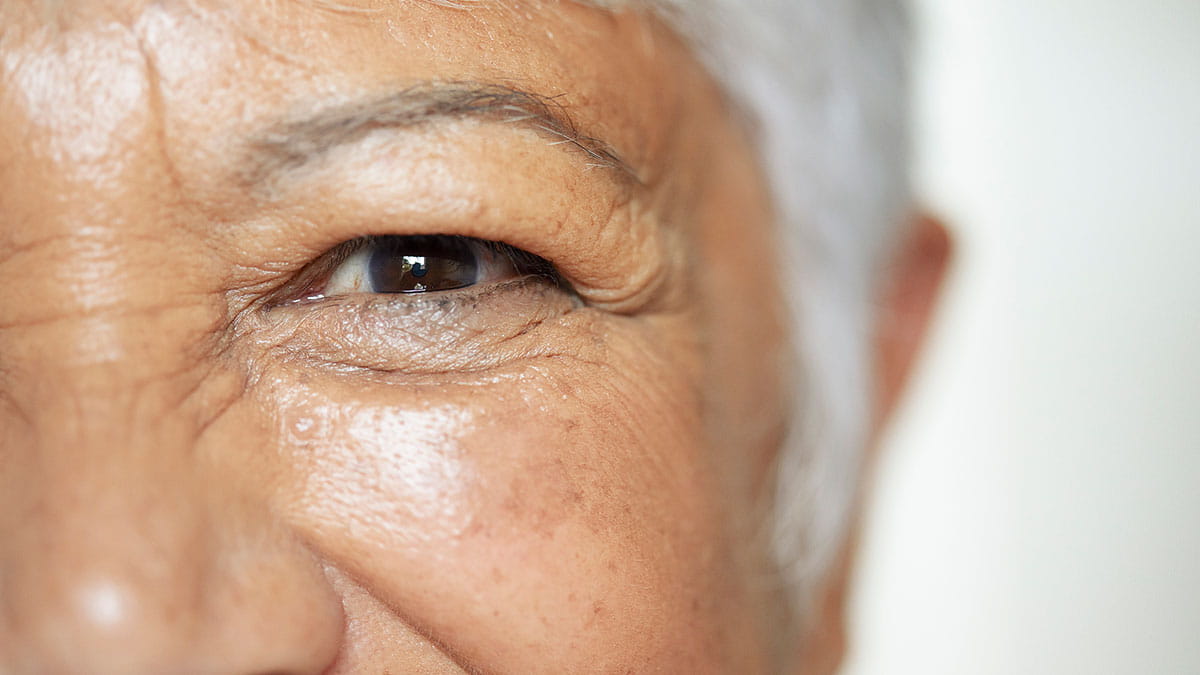Blog article
Eye health quiz

Take our eye health quiz to learn more about common vision conditions, protective habits, and surprising facts about the human eye. Good luck!
Questions
1. What percentage of blindness and vision impairment in Australia is preventable or treatable if detected early?
a) 40%
b) 50%
c) 80%
d) 90%
2. Select the most common eye condition(s) that affect Australians:
a) Macular degeneration and other retinal diseases
b) Cataracts
c) Glaucoma
d) Diabetic retinopathy
e) Refractive errors
f) All of the above
3. Which of the following is not a typical symptom of age-related macular degeneration (AMD)?
a) Difficulty reading even with glasses
b) Dark patches in the centre of vision
c) Complete loss of peripheral vision
d) Seeing wavy lines that appear bent
4. True or false: Cataracts are the leading cause of blindness in adults worldwide.
a) True
b) False
5. Which of the following increases your risk of developing cataracts?
a) Smoking
b) Long-term UV exposure
c) Family history
d) All of the above
6. True or false: There are no pain nerves inside the eye, meaning serious conditions like glaucoma can develop without noticeable symptoms.
a) True
b) False
7. How often should adults get their eyes tested?
a) Every year
b) Every 2 years
c) Every 5 years
d) Only when vision changes
8. True or false: You should wear sunglasses even in winter to protect your eyes from UV rays.
a) True
b) False
9. Which of the following is not a visible part of the eye?
a) Iris
b) Cornea
c) Retina
d) Pupil
10. How many times does the average person blink in one minute?
a) 5-10
b) 15-20
c) 30-40
d) 50+
11. If the human eye were a digital camera, how many megapixels would it have?
a) 100MP
b) 250MP
c) 576MP
d) 1,000MP
12. Red-green colour blindness is found in:
a) 2% of males and 0% of females
b) 4% of males and 0.2% of females
c) 8% of males and 0.4% of females
d) 10% of males and 1% of females
13. The retina is made up of two types of light-sensitive cells – what are they called?
a) Discs and plates
b) Rods and cones
c) Pixels and lenses
d) Fibres and nerves
14. The iris (the coloured part of your eye) has how many distinct features?
a) 10 features
b) 40 features (same as fingerprints)
c) 100 features
d) 256 features
15. Why do eyes sometimes appear red in flash photography?
a) The cornea reflects the light
b) The pupil dilates too quickly
c) The retina is densely packed with blood vessels
d) The optic nerve absorbs the light
16. A fun one to finish! Which animal has the most eyes?
a) Spiders
b) Zebra mussels
c) Rock scallops
d) Sea anemones
Answers
1. What percentage of blindness and vision impairment in Australia is preventable or treatable if detected early?
d) 90%1
It’s one of the reasons regular eye tests are so important.
2. Select the most common eye conditions that affect Australians:
f) All of the above
Macular degeneration is a leading cause of vision loss in Australians over 50, damaging the macula, the part of the retina responsible for sharp central vision.2 Cataract are the clouding of the eye’s lens that leads to blurred or foggy vision, increased sensitivity to glare, and difficulty seeing in low light.3 Glaucoma is a group of eye diseases that damage the optic nerve due to increased pressure in the eye.4 Diabetic retinopathy is a complication of diabetes that affects the blood vessels in the retina, leading to vision problems, floaters, and potential blindness if untreated.5 Refractive errors are the most common cause of vision impairment, and include short-sightedness (myopia), long-sightedness (hyperopia), astigmatism (uneven curvature of the cornea), and presbyopia (age-related difficulty focusing on close objects).6
3. Which of the following is not a typical symptom of age-related macular degeneration (AMD)?
c) Complete loss of peripheral vision
AMD mainly affects central vision, not peripheral. a) Difficulty reading even with glasses; b) Dark patches in the centre of vision; and d) Seeing wavy lines that appear bent are all textbook symptoms of AMD, as are gradual or sudden worsening in your vision, difficulty seeing faces clearly, needing brighter light to read and decreased night vision and colour vision.2
4. True or false: Cataracts are the leading cause of blindness in adults worldwide.
a) True
While found predominately in older people, younger people can also get cataracts.3
5. Which of the following increases your risk of developing cataracts?
d) All of the above
Genetics, UV exposure, and lifestyle factors all contribute to cataract risk. Additional risk factors include diabetes, using corticosteroid medicines for long periods, eye injuries, and some types of eye operations.3
6. True or false: There are no pain nerves inside the eye, meaning serious conditions like glaucoma can develop without noticeable symptoms.
a) True
Serious conditions like glaucoma can progress without pain, making regular check-ups vital.4
7. How often should adults get their eyes tested?
b) Every 2 years
It’s generally recommended to have an eye test every two years, even if you don’t experience noticeable vision issues (remember Question 1?). However, if you have an existing eye condition, a family history of eye disease, or risk factors like diabetes or high blood pressure, more frequent eye exams may be necessary to detect any changes early and prevent complications.2 If you’re unsure, chat to your GP or optometrist.
8. True or false: You should wear sunglasses even in winter to protect your eyes from UV rays.
a) True
While sunnies are must-have on sunny days, Australia’s harsh UV rays can still damage your eyes even when it’s cloudy, increasing the risk of cataracts, squamous cell cancers on the eye’s surface, and skin cancer around the eyes. To stay protected, the Cancer Council recommends wearing wraparound sunglasses year-round.7
9. Which of the following is not a visible part of the eye?
c) Retina
We hope you all got this one! The retina is the inside of the back of your eye, meaning it isn’t visible without special imaging. The iris is the coloured part of your eye; the cornea, the clear dome over your iris; and the pupil, the black hole in the centre of your iris.1
10. How many times does the average person blink in one minute?
b) 15-208
Blinking plays a crucial role in keeping your eyes moist, oxygenated, and free from debris, helping to prevent dryness and irritation.9 However, this natural reflex slows down dramatically when looking at screens, with studies suggesting that blink frequency can decrease by up to 66%!10 This reduced blinking can lead to dry eyes, discomfort, and digital eye strain, which is why it’s important to take breaks, consciously blink more often, and follow the 20-20-20 rule (looking away from the screen every 20 minutes for 20 seconds at something 20 feet or 6 metres away).11
11. If the human eye were a digital camera, how many megapixels would it have?
c) 576MP
While impossible to calculate precisely, experts estimate that the human eye has the equivalent of around 576MP.12 For comparison, the iPhone 16 Pro Max boasts just 48MP. Apple who?
12. Red-green colour blindness is found in:
c) 8% of males and 0.4% of females
Red-green colour blindness is the most common form of colour vision deficiency, affecting approximately 8% of males and 0.4% of females. Those with red-green colour blindness have difficulty distinguishing between shades of red, green, yellow, and orange.13
13. The retina is made up of two types of light-sensitive cells – what are they called?
b) Rods and cones
Rods are highly sensitive to light and allow us to see in low-light or nighttime conditions, but they do not detect colour and provide lower detail. In contrast, cones function in brighter light and are responsible for colour vision and sharp detail.14 A little power couple!
14. The iris (the coloured part of your eye) has how many distinct features?
d) 256 features
Our irises are incredibly unique – containing over six times the number of distinct features compared to a fingerprint.15 This high level of detail makes iris recognition one of the most secure and reliable forms of biometric identification.
15. Why do eyes sometimes appear red in flash photography?
c) The retina is densely packed with blood vessels
Nothing supernatural here, unfortunately! In low light, the pupil widens to let in more light, and when a sudden flash occurs, light bounces off the retina before the pupil can contract, creating a red reflection. Normally, the eye absorbs most light, but the intense brightness and angle of a flash make the redness visible.16
16. Which animal has the most eyes?
c) Rock scallops
While insects like dragonflies might seem like contenders for the title of "most eyes," their large, multifaceted compound eyes are actually made up of thousands of tiny lenses, rather than separate organs of vision. Therefore, the true record-holder for the most eyes in the animal kingdom is the rock scallop, which has over 200 tiny, iridescent blue eyes lining the edge of its mantle, allowing them to react to predators despite having no brain – creepy right?



